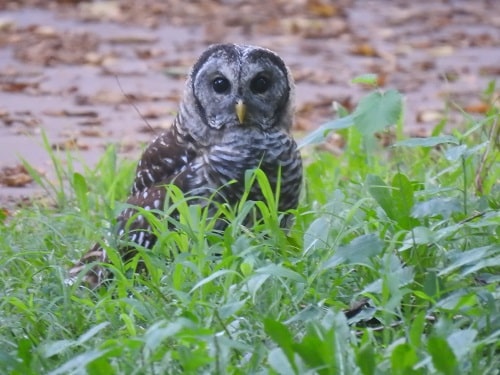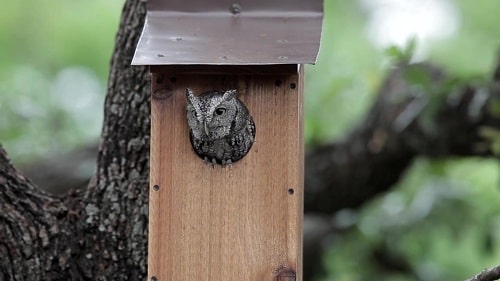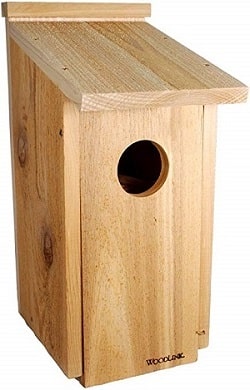A Guide of Information About Owls and Their Habits
Got a question about Owls? Let's uncover the mysteries of these birds of the night.
How Owls See
The large eyes that face forward owls to have binocular vision, enabling them to judge distances between objects, and maneuver through crowded environments.
The eyes of owls are immovably fixed in their sockets. Meaning, for the bird to follow moving objects it must turn its head.
Because they have long flexible necks, they can turn their heads 260 degrees.

Barred Owl
How Owls Hunt
One of the most interesting things about owls is their ability to find food at night. How do they do that?
To begin with, the flight feathers of owls are serrated at their tips, which have the effect of muffling the flapping sound of their wings during flight.
Their quite flight allows them to go undetected when hunting for food. Few birds of this species hunt prey in full daylight.
Their hearing is particularly important in finding food.
Many have asymmetrical skulls, with ear openings at different levels. The right ear is positioned high on the head, while the left ear is low.
This allows sound to reach one ear before the other, enabling them to get a "fix" on the sound made by a prey animal.
In experiments performed in totally dark rooms where eyesight is useless, owls have caught mice on a leaf-littered floor with 100% accuracy.
Toes Help In Hunting
The toes of owls play an important role in both capturing game and while perching to watch for animals.
The term zygodactyls means having two toes in front and two in back. This is the case with owls.
The difference for owls is that two toes point forward, one toe points backward, and the outer toe of each foot can turn either way.
Forward pointing allows for a firmer grasp of prey and more to the back for perching strength.
Feeding Habits What Owls Eat
The food owls eat depends on the species of the owl. They do not eat seeds and berries.
Instead, Owls feed on living animals with the size of the prey proportional to the size of the bird.
From small insects to mammals as large as hares. A Barn Owl, for instance, may eat mice, rats, and voles.
A Barred-Owl may also eat the same things as Barn Owls but will add snakes, salamanders, and frogs to its diet.
They may catch a bird at your feeder from time to time. Usually, those birds that feed on the ground are at a greater risk.
The Great Horned Owl will take large prey such as crows, ospreys, and falcons.
Any food that is indigestible to these birds, such as bones, hair, and feathers, is compressed and regurgitated as compact pellets.
These pellets can aid in understanding what the birds eat by analyzing the contents within them.
Will Owls or Hawks Attack my Dog or Cat?
Possibly, but not so much for food. More likely, your dog or cat is getting too close to a nest site.
It's recommended to monitor any pets under 15 pounds while they're outside.
I've personally watched as a Barred Owl swooped down and scratched a grown man. He accidentally stopped by a tree where a young owl was perched. He survived.
Like most other raptors, these birds have sharp talons for seizing and holding prey. Their hooked beak is designed for tearing meat.
Where Do Owls Nest
The nesting habits of Owls vary considerably. Some nest in former Hawk and Crow nests. At the same time, others nest among rocks high on clifts.
Still, others are cavity nesters living in holes in trees built by woodpeckers and other bird species.
All Owls lay pure white eggs. These are laid over several days, and incubation begins with the laying of the first egg.
It can take 28 - 35 days before the eggs hatch.
Depending on the species, as many as 14 eggs may be laid. The larger clutches happen when food is plentiful. Less food, fewer eggs laid.
| As an Amazon Associate, wild-bird-watching earns from qualifying purchases. See our Privacy Policy |
The first eggs to hatch will have a better chance of survival than the latter.
Older nestlings will be able to compete for food over the younger and smaller birds in the nest.
If food is plentiful, all nestlings have a better chance of survival.
Nestlings have enormous appetites and can eat their weight in food in a single night.
Depending on Owl species and location, the breeding or mating season begins late winter to early spring. Only one nesting each year.
Some Owls Use Birdhouses
Several owl species can be attracted to man-made bird houses. Screech Owls, Barn Owls, and Great Horned, to name a few.
Since they don't build a nest but reuse cavities and nests of other birds, there isn't a list of nesting materials.

Screech Owl Nestling Ready for Flight
If you supply a bird house for them, place a few cedar shavings in the bottom. The type used in pet bedding will work.
With the decline in natural habitat, many farmers have begun placing birdhouses on poles or the side of barns to attract nesting owls.
Online live nest cameras are used to stream the activity of Barn Owls, allowing internet users the opportunity to watch and learn in real time.
One of our favorites is Star Ranch. While the Barn Owls are favorites, they provide other cams.
One of the more practical reasons for wanting to attract these birds is to control rodent populations. This minimizes the need for chemical poisons.
When Do Baby Owls Leave the Nest
Unlike a lot of other species, baby owls don't just fly out of the nest and begin their lives.
When they are about five weeks old, a nestling owl may venture to a branch where it will exercise its wings. The adults will continue to bring food.
Short flights will be taken over the next few days and by ten weeks of age, the young will be able to fly.
However, the adults will continue to provide food and teach them survival skills for several more months.
Where Do Owl Myths Come From
Locating these birds can be difficult since their movement during daylight is minimal. Their camouflage feathers help them blend in with their habitat.
All of this leads to myths and folklore about these birds. Some believe he is wise, while others consider he represents doom.
The reality is, they are a species of bird. Like any other bird, you are free to attribute to them what you wish. They won't mind.
Either way, they are a valuable species for us and the planet we share.





